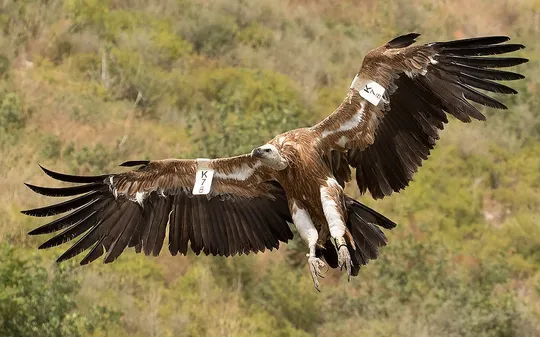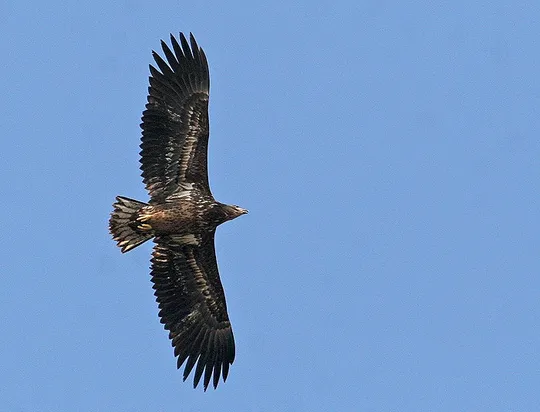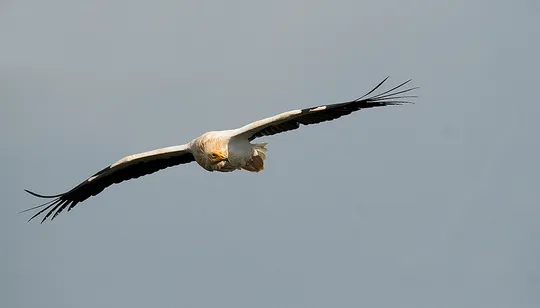Aquila fasciata
 Critically Endangered
Critically Endangered
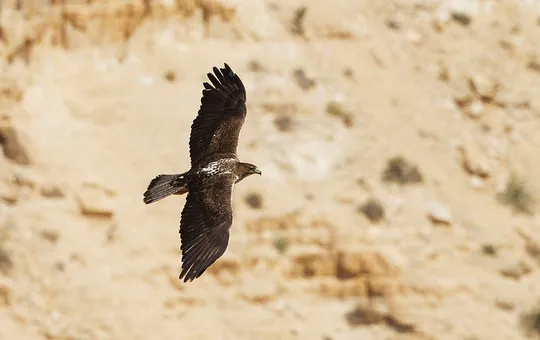

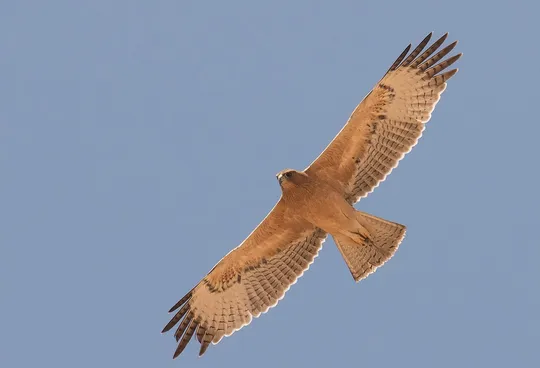
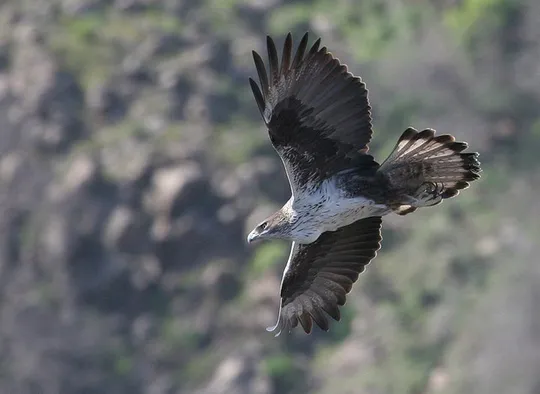
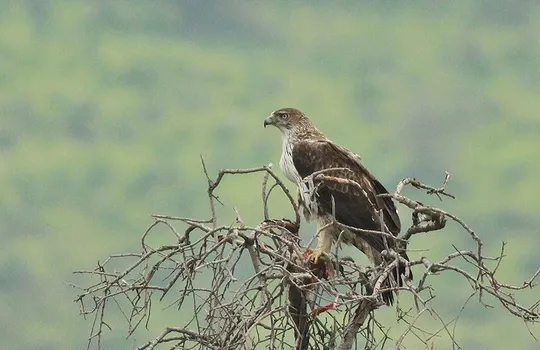
| Habitats | Desert Cliffs, Mediterranean Cliffs |
|---|---|
| Presence In Israel | Resident |
| Breeding In Israel | Breeder |
| Migration Types | Resident |
| Zoographical Zones | Mediterranean, Irano-Turanian, Saharo-Arabian |
| Landscape Types | Mountainous, Cliffs |
| Vegetation Types | Mediterranean Garrigue, Steppe |
| Vegetation Densities | Medium, Low |
| Nest Locations | Cliffs |
| Diet Types | Terrestrial Vertebrates |
| Foraging Grounds | Ground, Aerial |
| Body Sizes | Large (over 1000g) |
| Threat Factors | Nest Harvesting, Electrocution and collision with transmission wires, Human Settlements in Gorges, Hikers and rock climbers, Pesticide Poisoning, Lead Poisoning, Helicopter and aircraft activity in breeding areas, Hunting and trapping |
Bonelli’s Eagle is a medium-sized, fast and aggressive eagle. Adult plumage is contrasting – the breast, belly and lower parts are white with black streaking, contrasting with dark brown upper parts, except for a white patch in the center of its back. Immature birds have a more uniform light brown rusty plumage. It resembles hawks in many features – the white streaked plumage, the long legs, yellow eyes, rounded long tail and its habit of hunting doves and other birds in the air.
A very rare resident species in the Golan Heights, eastern Samaria, the Judean Desert and the Negev. The Mediterranean population comprises only a few pairs and in the desert region less than ten pairs remain. It once nested in all the mountainous and cliff areas, from the Upper Galilee to Eilat. The population in northern Israel was seriously affected in the 1960s and 1970s from excessive use of agricultural pesticides, which led to the disappearance of all the pairs that bred in the Galilee, the Carmel and the Judean Mountains. During the 1980s and 1990s, most of the pairs that nested in Samaria were adversely affected by nest robbers, and nesting in the Eilat Mountains ceased as well. Dispersing juveniles are frequently harmed by electrocution on medium-voltage distribution lines.
According to the quantitative analysis conducted (population viability analysis, PVA), at the current reproductive rate the probability of extinction for the species in Israel approaches 100% and the mean extinction time is 51 years (Mayrose & Hatsofe 2017).
The major threat to the Bonelli’s Eagle population is electrocution. Every year a number of juvenile eagles are electrocuted in their post fledging dispersal areas.
During recent decades, extensive efforts have been made to preserve the Bonelli’s Eagle population in Israel. All the known nesting sites are continuously monitored, and some of them are guarded against robbers. Moreover, rock climbing and aerial activities in the vicinity of nesting sites is restricted. Efforts have been made to insulate electrical poles in the juvenile dispersal areas. In addition, a number of immature birds from the captive breeding nucleus in the "Hai-Bar Carmel" are released into the wild every year.
Bonelli’s Eagle is classified as Critically Endangered (CR) and its future is completely dependent on specific management actions taken to ensure its preservation. If no solution is found to the electrocution issue, the population in Israel is not viable in the long-term.
It is necessary to minimize the danger to Bonelli’s Eagle from overhead power lines. Until a complete or partial solution to the problem is found, the continuous release of captive bred individuals is essential. At the same time, monitoring and nest guarding actions should be implemented to maximize the population reproductive potential.
- מירוז, א. והצופה, א. 2014. סיכום סקר קינון עופות דורסים במדבר יהודה. דו"ח רשות הטבע והגנים.
- מירוז, א. והצופה, א. 2017. על מצב אוכלוסיות העיט הניצי והעיט הזהוב בישראל - סיכום נתונים והיערכות לעתיד. דו"ח רשות הטבע והגנים, חטיבת מדע.
- פז, ע. 1986. עופות. מתוך אלון, ע. (עורך), החי והצומח של ארץ ישראל. כרך 6. הוצאת משרד הביטחון, ישראל.
- פרומקין, ר., מן ש., 1984 .קנון דורסים בחבל המדברי של ישראל 1984-1980. העזניה גליון 11. הוצאת החברה להגנת הטבע.
- פרידמן, ג. 2010. סיכום סקר דורסי יום במחוז צפון. דו"ח עבור רשות הטבע והגנים והחברה להגנת הטבע.
- Mendelssohn, H. 1972. The impact of pesticides on bird life in Israel. ICBP 11:75-104.
- Shirihai, H., 1996. The Birds of Israel. Academic Press, London.
- Symes, A. 2013. Species generation lengths. Unpublished, BirdLife International.
- Species page at Birdlife International
Current Occupancy Map
| Data Missing | Sporadic | Limited Sites | Low Density | High Density |
|---|---|---|---|---|
| 0 | 0 | 0 | 0 | 0 |
Distribution maps
The maps presented here provide visual information on the distribution of species in Israel from the past and present, and the changes in occupancy and breeding density during the comparison period. For further reading
Relative Abundance 2010-2020
Breeding density values in the current decade as determined from experts' opinion and observations from databases.
| Data Missing | Sporadic | Limited Sites | Low Density | High Density |
|---|---|---|---|---|
| 8 | 12 | 12 | 21 | 19 |
Relative Abundance 1980-1990
Density values based primarily on the book The Birds of Israel (Shirihai 1996).
| Data Missing | Sporadic | Limited Sites | Low Density | High Density |
|---|---|---|---|---|
| 5 | 14 | 14 | 17 | 22 |
Occupancy 1990-2020
The map shows differences in the species breeding distribution between the 1980's breeding map and the current weighted breeding evaluation. Negative value - species previously bred in the grid and is not presently breeding; positive value - species has not previously bred in the grid and is currently breeding.
| Data Missing | No Change | Occupancy Increase | Occupancy Decrease |
|---|---|---|---|
| 6 | 35 | 1 | 9 |
Change in Relative Abundance 1990-2020
The map shows the changes in the relative abundance of a species in each of the distribution grids between the breeding map of the 1980s and the weighted current breeding evaluation. Negative values - decline in abundance; positive values - increase in abundance; zero - no change in abundance.
| 80 to 100 | 50 | 20 to 30 | No Change | 30- to 20- | 50- | 100- to 80- | Data Missing |
|---|---|---|---|---|---|---|---|
| 0 | 4 | 2 | 22 | 12 | 14 | 11 | 16 |
| Rarity | |
|---|---|
| Vulnerability | |
| Attractiveness | |
| Endemism | |
| Red number | |
| Peripherality | |
| IUCN category | |
| Threat Definition according to the red book |
 Contributed:
Contributed: 
